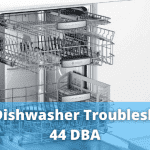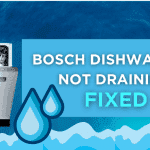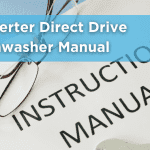Table of Contents
After you eat and put your dishes in the dishwasher, you expect them to be clean. But sometimes, you might open it and see dirty dishes and water at the bottom. This means your dishwasher should be getting rid of the water as it should.
Dishwashers should drain water out, but sometimes they need to. Let’s learn why this happens and how to fix it.
Comprehensive Dishwasher Draining Guides: Solutions by Brand
Need help with your dishwasher not draining? Whether you own a Frigidaire, Bosch, KitchenAid, or Samsung dishwasher, we’ve covered you with detailed guides to address this issue. Here’s a quick overview of solutions for each brand:
- Frigidaire Dishwasher: Facing draining problems with your Frigidaire unit? Our step-by-step guide can help you troubleshoot and fix the issue. Read our Frigidaire draining guide here.
- Bosch Dishwasher: Bosch dishwashers are known for their quality but can also have issues. Check out our comprehensive guide for solving drainage problems. Here’s our Bosch draining guide.
- KitchenAid Dishwasher: If your KitchenAid dishwasher isn’t draining water properly, don’t fret. We’ve put together a detailed guide to get it working again. Follow our KitchenAid draining guide.
- Samsung Dishwasher: Samsung dishwashers, though reliable, can sometimes have drainage issues. Dive into our guide to find out the fixes. Check out our Samsung draining guide.
- GE Dishwasher: GE Dishwasher Not Draining!
- Amana: Amana Dishwasher Not Draining!
- Kenmore: Kenmore Elite Dishwasher Not Draining!
Ensure to follow the specific steps tailored for your dishwasher’s brand for effective troubleshooting. Now, Let’s look at other dishwasher brands that need draining.
Steps to Unclog a Dishwasher
1. How a Dishwasher Gets Rid of Water
The dishwasher has a hose that sends water to the pipes near your sink. Sometimes, these pipes get old and need fixing, or there’s stuff blocking the bottom of the dishwasher. If your dishwasher isn’t draining, you’ll find water and some food bits at the bottom.
2. When There’s Water Left in the Dishwasher
If you see water at the bottom of your dishwasher, try running it again. Sometimes, it doesn’t finish cleaning if it’s stopped in the middle. Running it again might fix it.
If water is still there after trying again, you must check it out. Make sure to turn off the electricity to the dishwasher first.
To check inside, you need to get rid of the water. Put towels on the floor near the dishwasher and have a bucket close. Scoop out as much water as possible, then use towels to dry it.
You can also use a machine that sucks water (wet vac) to get it all out. Once the water’s gone, you can see what’s wrong with your dishwasher.
3. Check the Drain Hose
The drain hose is a key part of your dishwasher’s draining system. The tube carries the used water from the dishwasher to your home’s plumbing, often at the sink or garbage disposal.
- Connection: Ensure that the hose is securely connected to the dishwasher and the sink or garbage disposal.
- Obstructions: Inspect the inside of the hose. Over time, food particles or other debris might build up and block the hose.
- Ensure it’s clear and free from any blockages.
2. Examine Key Drainage Components
Certain parts of the dishwasher play a vital role in draining water. It’s essential to ensure they are in good condition.
Hose Clamp and Drain Solenoid:
- These components are crucial for the operation of the drain valve.
- Check for wear and tear or any signs of damage.
- If they look worn out or broken, consider replacing them immediately.
4. Operate the Garbage Disposal
Many built-in dishwashers are designed to drain through the garbage disposal. Therefore, it’s crucial to ensure the disposal is working correctly.
Turn it On:
- If leftover food or debris is in the disposal, turning it on might clear the pathway for the dishwasher to drain.
Loud Noises or Clogs:
- If the disposal makes unusually loud noises when on, it might be clogged.
- Consider using a drain cleaner to remove any obstructions.
- If problems persist, further troubleshooting of the garbage disposal might be necessary.
5. Inspect the Sink’s Air Gap Cylinder
The air gap is an essential safety feature, ensuring that water flows in the correct direction and that dirty water doesn’t get back into the dishwasher.
Location:
- The air gap cylinder is typically situated behind the sink connected to the dishwasher outlet hose.
Check Inside:
- Open it up and ensure that there’s no buildup or blockage inside.
- Clean out any debris you find and make sure it’s properly secured.
6. Look at the Dishwasher Filter
Clean Inside:
- After checking the pipes, look at the bottom of the dishwasher for any leftover food or waste.
- Wipe it clean with a cloth or a rough sponge.
Find the Filter:
- This is usually at the back or bottom near the part that sprays water.
- Some new dishwashers have little barriers to stop food from getting to the filter, but sometimes stuff still gets there.
Clean the Filter:
- Use a screwdriver to open its cover.
- Please take out the filter and wash it.
7. Try Baking Soda and Vinegar
Mix:
- If the dishwasher is still not draining, mix with the same amount of baking soda and vinegar.
Use the Mixture:
- Pour your baking soda and vinegar mix into the bottom part of the dishwasher.
- Wait for about 15 minutes.
Rinse:
- After waiting, pour hot water into the dishwasher.
- Then, run the dishwasher on a rinse setting.
This can help clean any blockages in the dishwasher’s drain.
8.How to Prevent Dishwasher Clogs
Clean Your Dishes First:
- Before putting them in the dishwasher, shake off food crumbs and leftovers.
Use Hot Water:
- Pick a cycle with hot water when you wash dishes. It helps clean better.
Keep It Clean:
- Clean the inside and outside of your dishwasher regularly. Wipe down all parts you can reach.
Check the Filter:
- Look at the filter from time to time. Remove anything that shouldn’t be there.
Use It Often:
- Run your dishwasher regularly, and always use dishwasher soap. This helps keep things flowing.
Remember, if your dishwasher isn’t draining and you can’t fix it, it’s okay to ask a pro for help.





[…] you attempt to unclog a dishwasher drain with Drano, the drain pipe may not be the only thing that gets damaged. The […]